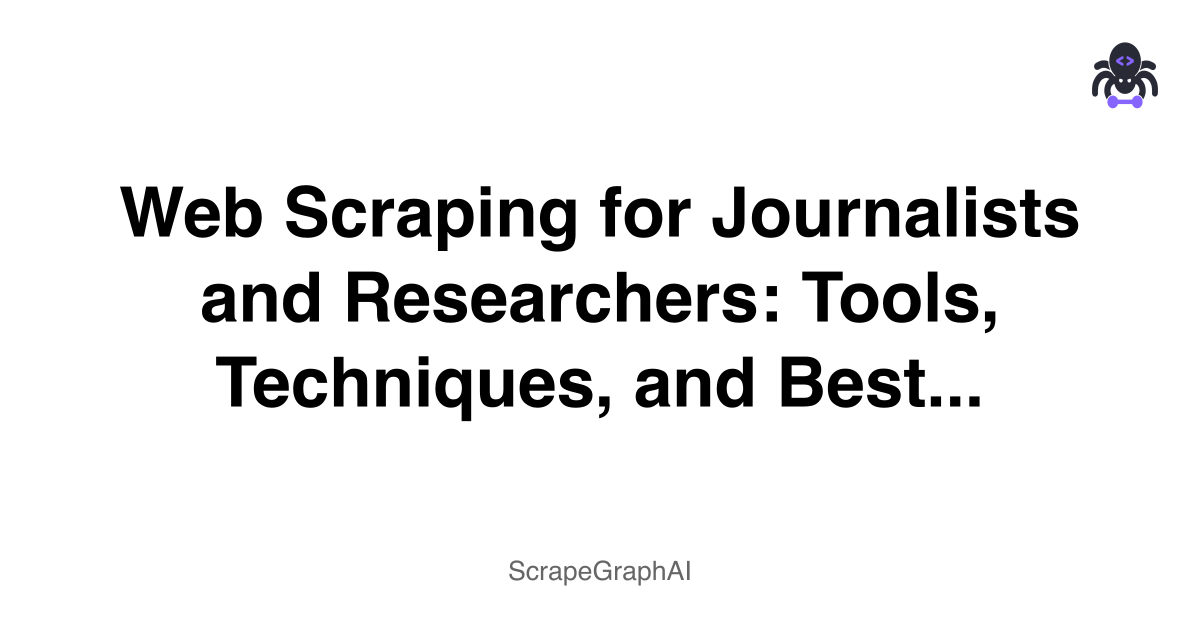In the digital information age, journalists and researchers face a paradox: valuable public data is more abundant than ever, yet scattered, inconsistent, and often locked behind poorly designed websites. Government spending reports, statistical releases, policy documents, and institutional announcements are frequently published online—but not in easily downloadable formats. Web scraping offers a solution, allowing professionals to collect, structure, and analyze critical information at scale. This blog focuses on using ScrapeGraphAI to ethically extract public-interest data in a repeatable and publication-ready manner.
Why Journalists and Researchers Need Web Scraping
Manual data collection is time-consuming and error-prone. Important datasets such as annual budgets, demographic statistics, and press releases are often buried inside pages with dynamic tables, expandable rows, or printable views. By automating data extraction, journalists can track changes over time, uncover inconsistencies, and produce data-rich investigations. Researchers can supplement official datasets with scraped data to explore new angles and generate original insights.
Key applications include:
- Extracting spending data from finance ministries
- Scraping statistical indicators from government bureaus
- Monitoring public health dashboards
- Building citation maps from open-access publications
- Parsing legislative activity and regulatory documents
Why Use ScrapeGraphAI
ScrapeGraphAI is a schema-driven, LLM-powered scraping framework. It replaces brittle scraping techniques (like XPath and CSS selectors) with prompt-based logic and automatic structure detection. This makes it ideal for scraping sources with inconsistent formatting, changing HTML, or complex layouts.
ScrapeGraphAI Benefits for Public Data Projects
- Works on both static and dynamic web pages
- Accepts JSON schema to define output structure
- Uses plain language prompts for clarity
- Supports OpenAI and other LLM providers
- Outputs structured, validated JSON data for analysis
Example 1: Scraping Government Budget Allocations
Imagine a Ministry of Finance publishes budget tables online by department and year. Here's how ScrapeGraphAI extracts the core fields:
from scrapegraphai.graphs import SmartScraperGraph
from scrapegraphai.utils import convert_to_json_schema
schema = {
"department": "string",
"allocated_amount": "string",
"financial_year": "string"
}
graph = SmartScraperGraph(
prompt="Extract department name, allocated amount, and financial year",
source="https://example.gov/budget-2025",
schema=convert_to_json_schema(schema),
config={
"llm": {
"provider": "openai",
"model": "gpt-4",
"api_key": "your-api-key"
}
}
)
result = graph.run()
print(result)This schema can be reused for any ministry site that follows a similar format.
Example 2: Extracting Demographic Statistics
You want to collect employment and inflation rates from a national statistics bureau.
schema = {
"indicator_name": "string",
"value": "string",
"year": "string"
}
graph = SmartScraperGraph(
prompt="Extract the indicator name, value, and year from the statistics table",
source="https://example-bureau.gov/data-dashboard",
schema=convert_to_json_schema(schema),
config={
"llm": {
"provider": "openai",
"api_key": "your-api-key",
"model": "gpt-4"
}
}
)
data = graph.run()Example 3: Monitoring Policy Statements for Fact-Checking
Let's extract recent claims made by a public office from its press release section:
schema = {
"headline": "string",
"quote": "string",
"date": "string"
}
graph = SmartScraperGraph(
prompt="Extract headline, key quote, and date from each press release",
source="https://example-gov.in/press-releases",
schema=convert_to_json_schema(schema),
config={
"llm": {
"provider": "openai",
"api_key": "your-api-key",
"model": "gpt-4"
}
}
)
results = graph.run()This enables journalists to track consistency in statements, compare them to past positions, and verify timelines.
Best Practices for Responsible Scraping
- Use only publicly available, non-login-protected, open-access sources
- Respect
robots.txtand crawl rate limits - Always log the original URL, scrape timestamp, and extracted structure
- Validate fields manually for sensitive investigations
- Cite the data source in all publications or datasets
- Do not scrape copyrighted or private data without permission
Suggested Citation Format
When publishing or referencing scraped data:
Data extracted from [Website Name], accessed [Date], using ScrapeGraphAI. Source: [https://example.gov]
Example:
Spending records extracted from the Ministry of Education site on 10 July 2025 using ScrapeGraphAI. Source: https://education.gov/budget-spending
Recommended Resources
- ScrapeGraphAI GitHub: https://github.com/SuperAGI/ScrapegraphAI
- OpenRefine for data cleaning: https://openrefine.org
- pandas (dataframes and analysis): https://pandas.pydata.org
- csvkit for CLI spreadsheet tools: https://csvkit.readthedocs.io
- data.gov (India): https://data.gov.in
- data.gov (US): https://data.gov
Conclusion
Journalists and researchers are increasingly turning to data to support narratives, challenge claims, and produce impactful work. However, raw data is rarely delivered in a clean format. By using ScrapeGraphAI, you can automate the structured extraction of public data with reliability and transparency. Whether you're tracking policy spending, compiling statistical dashboards, or investigating regulatory records, ScrapeGraphAI makes the process reproducible, scalable, and publication-ready.
Related Resources
Want to learn more about data innovation and AI-powered analysis? Explore these guides:
- Web Scraping 101 - Master the basics of data collection
- AI Agent Web Scraping - Learn about AI-powered data extraction
- LlamaIndex Integration) - Discover advanced data analysis techniques
- Building Intelligent Agents - Learn how to build AI agents for data analysis
- Pre-AI to Post-AI Scraping - See how AI has transformed data collection
- Structured Output - Master handling structured data
- Stock Analysis with AI - Learn about AI-powered financial analysis
- LinkedIn Lead Generation with AI - Discover AI-driven business intelligence
- Web Scraping Legality - Understand the legal aspects of data collection
These resources will help you understand how to leverage AI and modern tools for innovative data collection and analysis.
